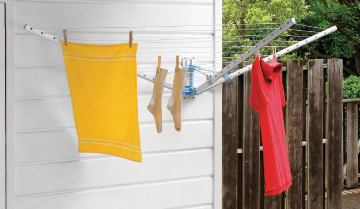THE URBAN HOME & GARDEN
The lost art of laundry

Fire Your Dryer!
Although a big-city lifestyle doesn’t exactly lend itself to dryer-free living, there are alternatives available to hitting the fluff dry button, allowing for energy and money savings and a lower carbon footprint – plus, your clothes will last longer! If the owners of the 90 million clothes dryers in American households line-dried their laundry for just 6 months a year, the total residential output of carbon dioxide in the United States would be reduced by over 3 percent. Here are some carbon-free alternatives:
Accordion dryers: Polder accordion dryers fold flat for storage, provide ample drying space, and are steel-constructed with nonskid plastic feet. Drying space usually ranges from 15 to 30 feet. These can be put outside on a deck or fit into a bathtub.
Pulley clotheslines: These may be hung building-to-building or building-to-pole and are an inexpensive alternative to electric dryers. These can be strung indoors or outdoors.
Octopus arm dryers: These are a new twist on an older style of drying rack that was popular in the 1930s and 1940s. Ideal for small indoor spaces, but perfect for outdoor use too, the octopus arm attaches to a wall to offer 40-plus feet of drying space. Then it simply folds down when not in use.
About your unmentionables: Retractable clotheslines can be easily strung in your bathroom to hold lighter loads and usually extend up to 8 feet or so. Polished metallic housings allow these clotheslines to be used either indoors or outdoors.
Clothespins: PVC-coated wire clothespins have a smooth finish that won’t snag delicate fabrics.
Hand Wash to Save Even More
If you’re really inspired, or for delicate fabrics, hand wash when possible. Clothes will last longer when washed by hand and not subjected to the wear and tear of a washer and dryer. The popular, aromatherapeutic Mrs. Meyer’s liquid laundry detergent line uses plant-based ingredients that are kind to your skin and easy on the environment. Sweet scents include lemon verbena, lavender, basil, and geranium.
Smoothing the Way
Ironing is truly a lost art with many people today who mistake tie-dye as an excuse not to iron. Nothing makes a good impression like a crisply pressed shirt! Here are some helpful tips:
Irons and Ironing Boards: Small tabletop ironing boards will work in a pinch, but consider a full size ironing board if you take your ironing seriously. Many ironing boards now feature Scotchguarded covers to keep them lasting a long time. Choose a self-cleaning steam iron for easy wrinkle removal.
Ironing Water: There is nothing better than freshly ironed clothes and bed linens. Recipes for ironing water used to be closely guarded family secrets passed down from grandmother to granddaughter. Start you own family tradition with this easy recipe, choosing the scent of your choice.
Scented Ironing Water
3 tablespoons of vodka
10–20 drops of scented essential oil
2 cups of distilled water
Mason jar or other tight-sealing jar
Mix the vodka and oil together; then add the distilled water (the vodka helps keep the oil and water mixed). Seal the jar tightly and shake well. Place in a dark spot for two weeks. Pour the ironing water in a spray bottle to use. Always test on a hidden seam or hem of your clothing or on the pillowcase. Store leftover water in the refrigerator for future use.
Julia Strzesieski is the marketing coordinator for Cole Hardware and can be reached at [email protected].


